| |||||||
| Search Forums |
| Advanced Search |
| Go to Page... |
 |
| Search this Thread |  45,468 views |
| | #1 | |
| Distinguished - BHPian  | DIY: Testing your car battery I recently bought a cheap battery tester. I thought I would share my experience and some thoughts about battery testing in general. This thread is about your regular 12V car battery. There are many different kinds of batteries on the market. I am not talking about battery capacity, but more about how the battery is constructed and what chemical principle it is based on. I believe the majority of car batteries in India tend to be what is known as sealed Lead Acid batteries. On more upmarket cars you might find AGM (Absorbed Glass Matt). You might still have a regular lead-acid battery in your car. If you need to check and occasionally top up the battery with distilled water, you have a regular lead acid battery. This thread is not about what type is best. We have various other excellent threads where this is discussed. This is just about me using my latest toy and sharing some thoughts about these cheap battery testers. The most obvious way of testing a battery is to hook up a simple voltmeter. Make sure the ignition is off and anything else that might draw power from the battery. You should leave some 10-15 minutes after shutting down the engine for testing. And if you had just started the car and shut it down again, you might want to wait a little longer. On modern cars, it can be tricky to test the battery voltage. Because modern cars tend to shut down various systems during the first 30-60 minutes. Certainly in the first 10-15 minutes, there might still be a considerable drain on the battery. (For more details see my thread about parasite drains: https://www.team-bhp.com/forum/techn...te-drains.html (Dealing with Electrical parasite drains) Irrespective of the exact type of brand, the rule of thumb a healthy battery would show about 12,6 Volts. Anything below 12,0 Volts is likely to indicate a battery going south. Just a small word of caution; when you are hooking up your multimeter, make sure the battery terminals, or whatever you attach them to, are very clean. It makes good sense to put a dollop of white Vaseline across battery terminals and connectors. It prevents water ingress and corrosion, but it will also act as a resistor and throw your measurements off. There are various other "tricks" as well. But it is surprisingly difficult to get a real understanding of your battery status. Two different parameters give a much better indication of your overall battery status. They are known as SOC (State of Charge) and SOH (State of Health). You can just glance over the next bit, bit boring all about definitions. Quote:
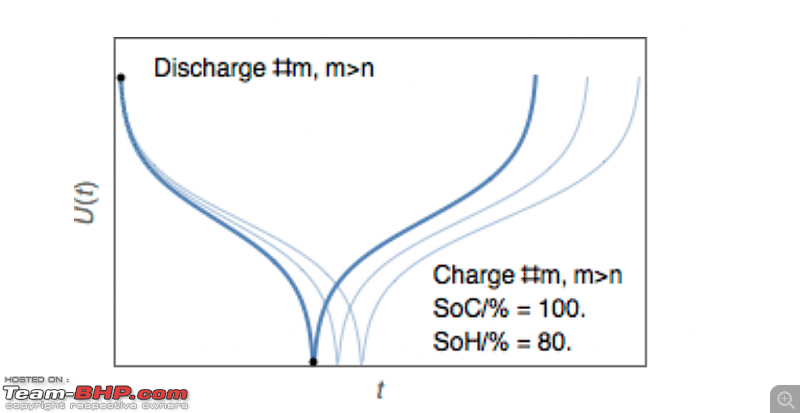 If you are interested check out this article that explains all of the above in some more detail: https://www.biologic.net/topics/batt...0Health%20(SoH). Those of you who follow my thread on fiddling with my cars might remember that over the last year or so, I have had several problems related to batteries. In some cases, it was the battery, but I also had to replace the alternator and currently, my Jaguar is suffering from a slightly too high quiescent current. I always had to rely on outside help to get my batteries tested, beyond doing a volt test myself. So I have seen a couple of different battery testers in use. It is surprisingly difficult to find detailed information on what makes a good battery tester. I will come back to this later. As I buy a lot of stuff from Chinese Websites such as AliExpress and Temu I also get a lot of "tool" related ads in my Facebook feeds and so on. I noticed a little battery tester at Temu. Marked down, from a Whopping Euro 150 to Euro 25. I am a sucker for such bargains, "take my credit card" is my response!! It arrived within about 10 days. 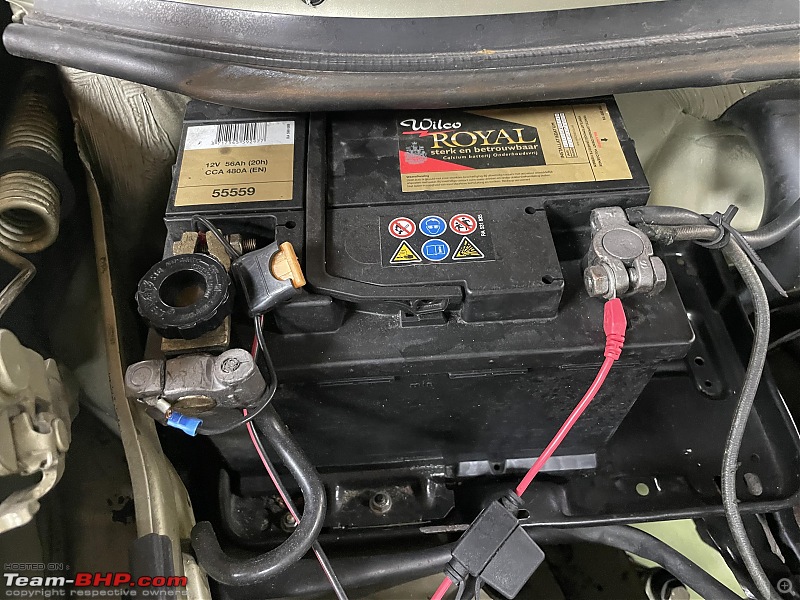 As you can see a very simple little box. The manual looks more elaborate than it is. Because it holds the text to this little box in about 35 different languages. So don't expect too many details. It is very simple to use, in theory at least. Again, as with the multimeter make sure you hook it up to clean metal parts of the battery and make sure the battery is not providing power to anything. If it's on a trickle charger take it off. You need to look for some details on your battery. Such as type and CCA (Cold Case Crank. Cold Cranking Amps (CCA) measure a battery’s ability to start an engine in cold climates. CCA tells you how many amps a 12-volt battery may support for 30 seconds at -17.8 degrees Celsius before the voltage drops to at least 7.2 volts per cell. As the ambient temperature drops, your battery provides less and less starting power. However, as the ambient temperature drops your engine will require more and more power to start! 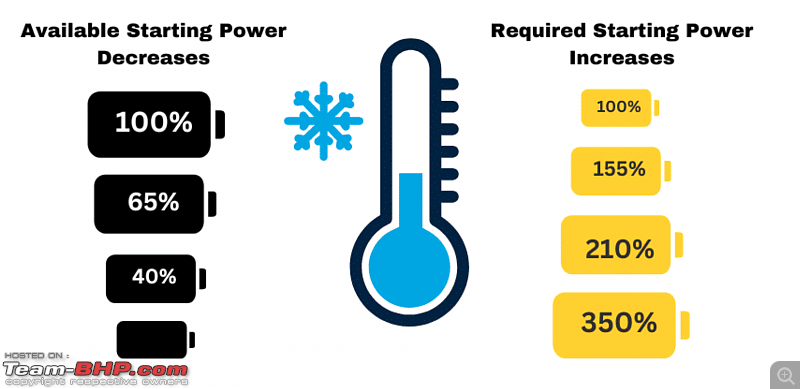 Finding the type of your battery might be a bit of a challenge. None of the six batteries in our fleet of cars had the type of battery mentioned. I had to resort to looking up each battery on the internet. When you hook up this little battery tester, it powers up automatically. You have to choose the type of battery and also enter the CCA value and against which norm the CCA was measured. (E.g. EN, SAE, IEC etc) Then it will run its almost instant test and come up with three relevant measurements. The first car I hooked it up to was my Mercedes W123:  Not sure about India, but here most batteries will have a date on them when they were installed. 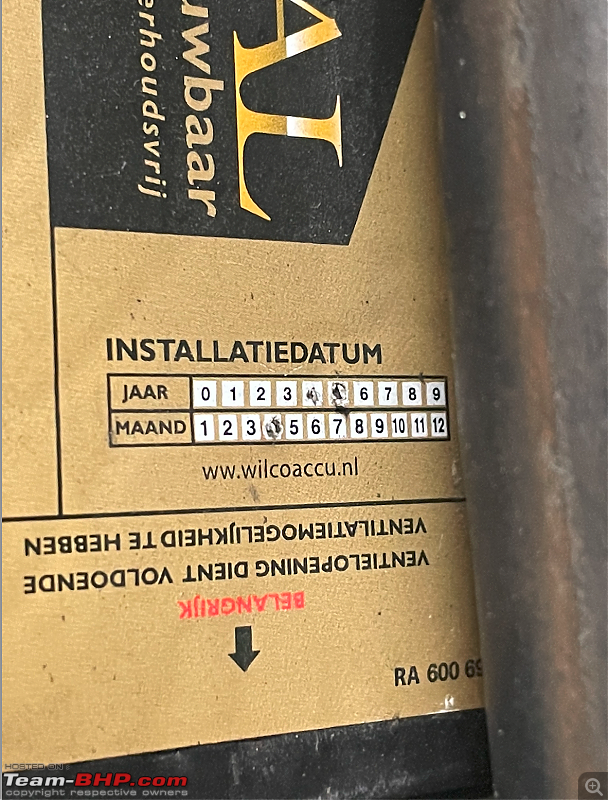 Note the sticker showing jaar (year) and maand (month). I checked with the invoice. I bought and installed this battery on March 14, 2015 (my birthday as it so happens!). This is for today's norms a relatively modest car battery. 56Ah and CCA of 480A Now let's see what my little, brand spanking new, battery tester thinks of this old battery!! It tells me the SOH is 75% and still good. Remember this is quite an old battery so it makes sense the SOH is quite low, but still good enough it seems. It also shows the internal resistance 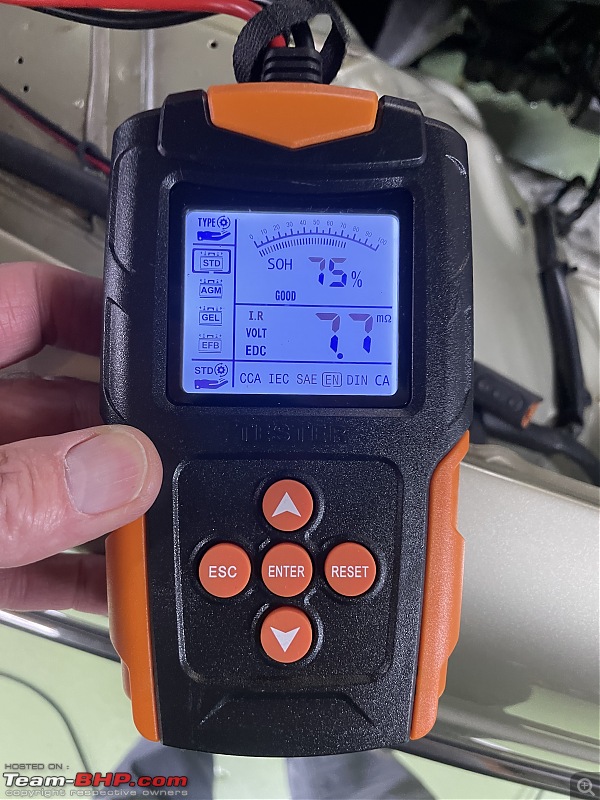 It also tells me the SOC is 98%, it also shows the nominal voltage of 12,7V 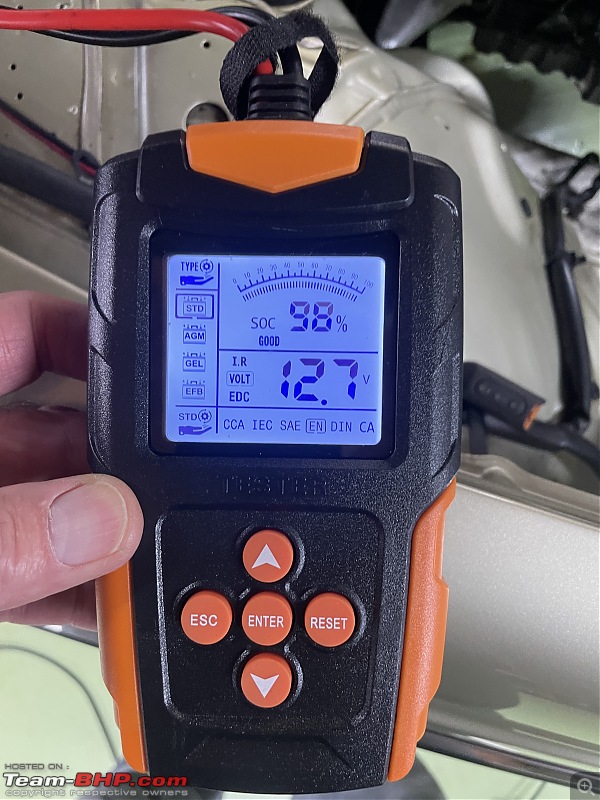 It also shows an EDC (Estimated Discharge Current) of 364A. This battery has a CCA of 480A. 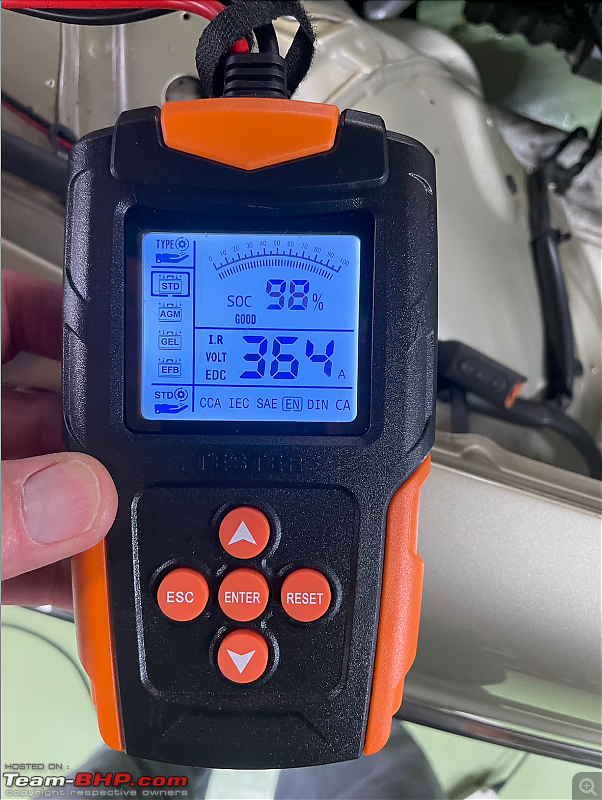 According to the manual, you can get the following readings for the SOH with the respective meanings SOH at least 90%: Battery life is perfect SOH at least 75%: Battery life is good SOH at least 50%: Battery life is bad Replace: The battery should be replaced as SOH is less than 50% Recharge: Re-test the battery after charging According to the manual, the tester will tell you when a clamp is not connected properly to the manual. I am not too sure how well that works. Because the next measurement I took on the Jeep and they were pretty awful. But when I reset the two test connectors everything was fine again. The Jeep has a much larger battery, 74 Ah and a CCA of 680A. I have also replaced it only earlier this year. But it has been completely discharged whilst in the care of the idiot VIP parking at Amsterdam Airport. So here are the results: The SOH shows 77% 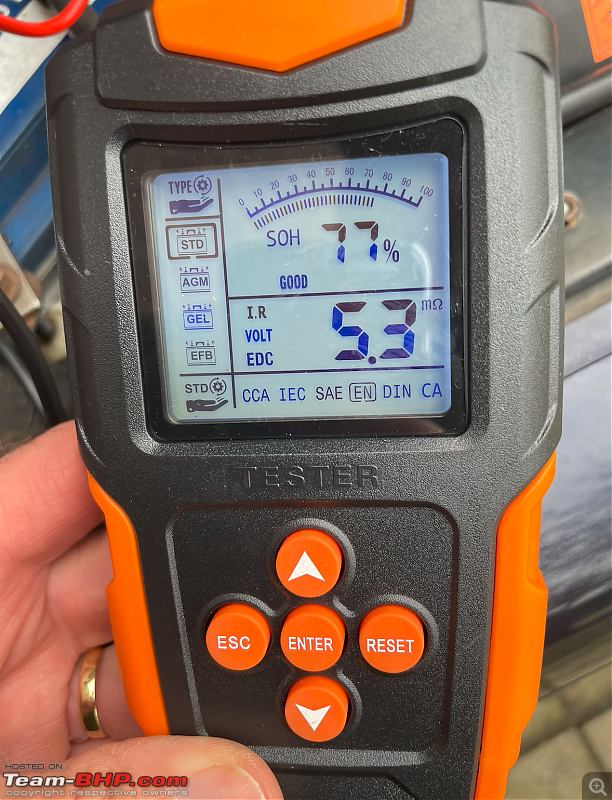 The SOC comes up as 95% 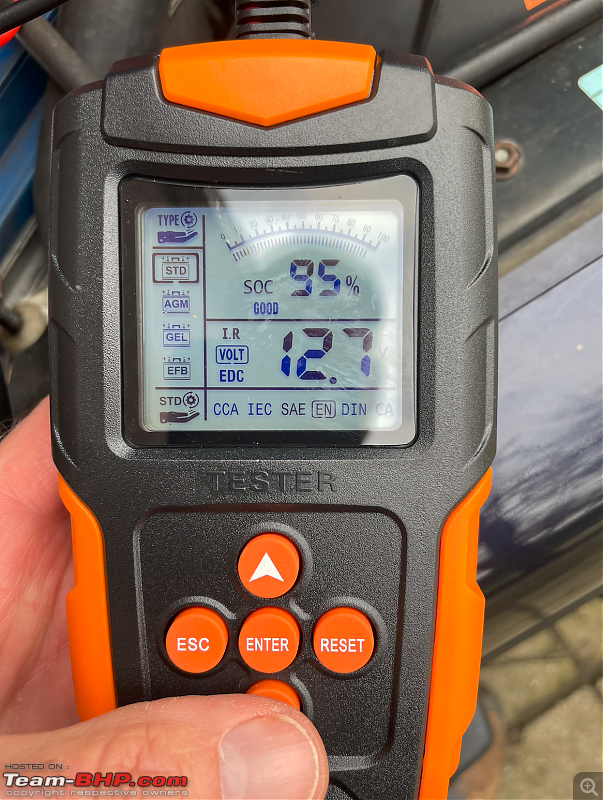 The CCA comes up at 524A 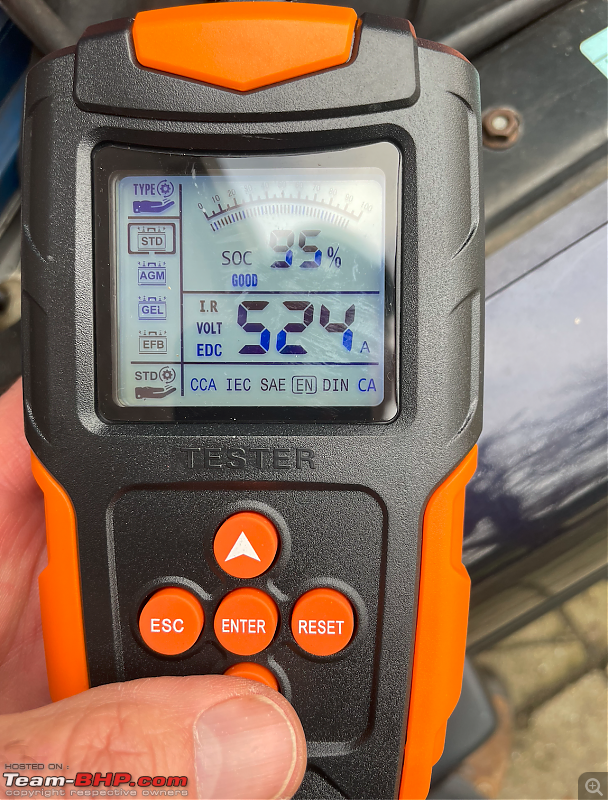 Just to illustrate you need to choose the correct battery type, or you are going to get a very unreliable reading. Here I am testing the Jeep Battery once again, but I have chosen the type as AGM. (Notice the left-hand vertical bar!) It tells me the SOH is 43% and to replace the battery!! 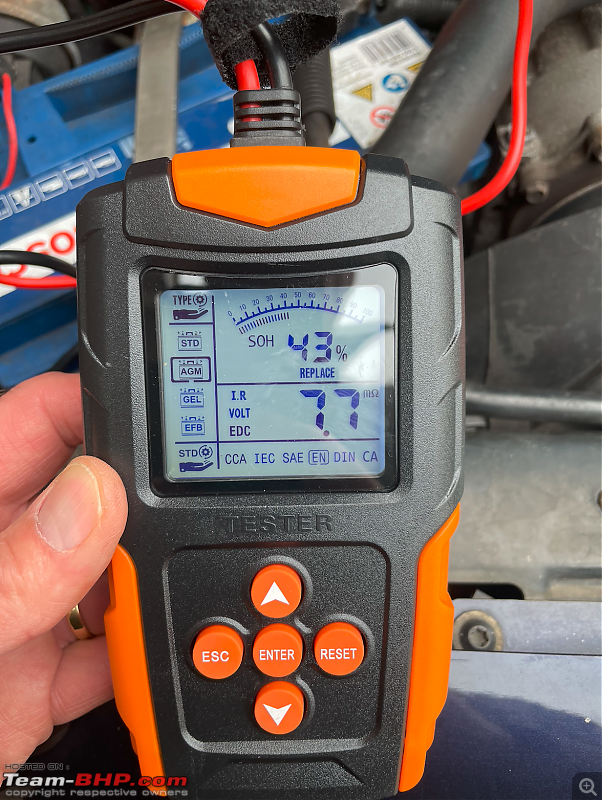 In all honesty, I am not yet convinced about this little battery tester. I will keep it and will bring it along when I get my battery tested with some professional battery testers. It seems to give an indication. All battery testers work by applying a load to the battery and monitoring that load. Without going into all the theory of battery tester, I think the more load and the longer it is applied the more reliable the results become. This tiny little box can't simulate much of a load. And the actual testing is almost instantaneous. Whilst I was tinkering with my digital multimeter and this battery tester I thought I would do another test. Modern cars rely heavily on a good healthy battery. It is worthwhile to note it is more important for a modern car to have a healthy voltage than to have a huge capacity. If the voltage drops below a certain threshold, the car's electronics won't work properly. 10 Volts will still crank your car quite sufficiently, but it might throw your ECU off and consequently, you won't be able to start. Poor battery connections, corrosion or not tightened properly will have the same effect. As a rule of thumb, the older cars, or rather the electronics, get the more susceptible they are likely to become to a proper supply voltage. Rule of thumb, you don't want it dipping much below 10,5V. When does your voltage dip? When you switch on your lights, AC whilst the engine is running. But of course, the largest dip is when starting. So I did a few tests. I used my Mercedes W123 once again. Because according to my battery tester, it has the battery with the lowest SOH. I took these little videos with my iPhone as SloMO. That's why the engine sounds more like a diesel. Look closely. You see the battery voltage at a nominal 12.49V. Then I start the engine and the voltage drops to about 10.4V and comes back up to about 14.4V. The 14.4V with the engine running is a good indication that the alternator is charging. It should be because I replaced it not too long ago. But doing these sorts of tests with a multimeter can be a bit deceptive. Although the display shows digital numbers and decimals, that in itself does not say anything about the accuracy. Digital multimeters have a sample rate, so they average out the measurements. Traditional analogue meters are much better at capturing these sorts of Voltage dips. Luckily, I collect old analogue meters. 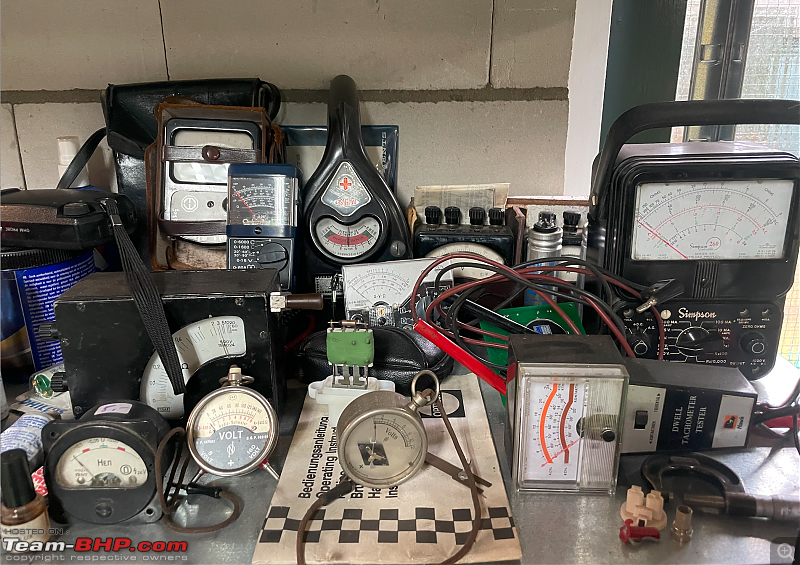 So, once again, the same test, but with an analogue meter hooked up to the battery You will have to take my word for it, the video is a bit shaky, better to see on my iPhone but the voltage drops to almost 8 Volts!! Not a problem for this old car with a carburettor and virtually no fancy electronics. But it would be a huge problem for a modern engine. It cranks fine, but the voltage crashes which will cause the ECU and other electronic components to go haywire. It is almost impossible to predict how long a battery will last. So many different factors are involved. If you have a battery that still requires the level of the electrolyte to be checked, do so regularly. Don't let it drop below the minimum level, on any cell. Most other batteries and certainly the sealed batteries don't require maintenance as such. However, if you can, putting them on one of these fancy trickle chargers does help. They top up the battery, but also discharge and charge it regularly. I am pretty sure one reason the W123 battery is lasting as long as it does, is it being hooked up to my trickle charger always when parked in my garage. 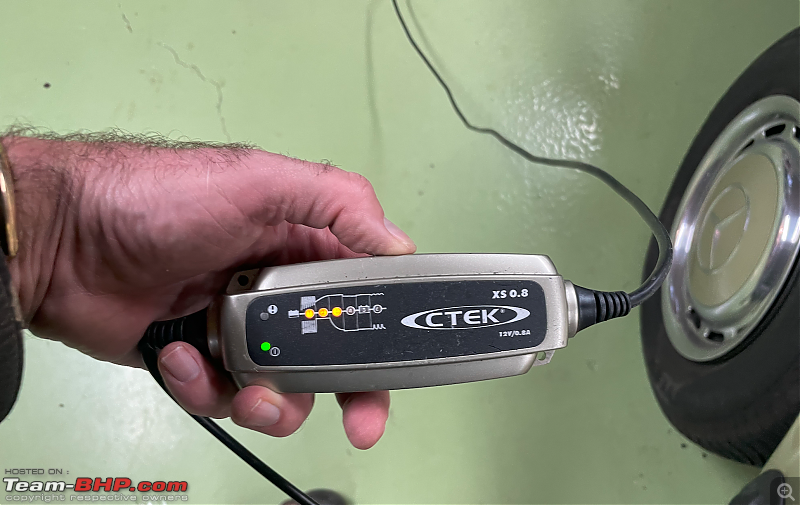 Jeroen  Last edited by Jeroen : 31st December 2023 at 22:06. | |
| |  (46)
Thanks (46)
Thanks
|
| The following 46 BHPians Thank Jeroen for this useful post: | aeroamit, amol4184, anandtheleo, arunphilip, ashking101, BeemerBug_06, Bimmerhead557, commander.sri, d.w.w., dailydriver, Driver 33, Gansan, gauravanekar, GForceEnjoyer, gischethans, GTO, Harjot37, HereticHermit, highway_star, JoshuaM, Kpzonwheels, Malliketh, MotorDev, motorsan, NiInJa, Nrulz, pd1108, PearlJam, PGA, PurpleTitanium, rajesh1868, rehaan2, RGK, robimahanta, saket77, sanjayrozario, Sedate driver, shancz, SilverSmoke, SRISRI_90, supertinu, tirumalavoleti, vaasu, venkyhere, Voodooblaster, vrprabhu |
| |
| | #2 |
| Team-BHP Support  | re: DIY: Testing your car battery Thread moved out from the Assembly Line. Thanks for sharing! |
| |  ()
Thanks ()
Thanks
|
| | #3 | |
| BHPian Join Date: Jun 2022 Location: Mumbai
Posts: 47
Thanked: 266 Times
| re: DIY: Testing your car battery Quote:
Quick question - do you know if letting the battery sit idle for prolonged periods (due to non-usage) leading it to fully discharge and then getting them recharged separately lead to accelerated deterioration and imminent death of a battery? I believe that should be the case and I am hoping to get a trickle charger for vehicles that are not regularly used. Would like to get your opinion on this as well. Last edited by Malliketh : 1st January 2024 at 12:34. Reason: Quotes | |
| |  (2)
Thanks (2)
Thanks
|
| The following 2 BHPians Thank Malliketh for this useful post: | gischethans, Jeroen |
| | #4 | |
| Distinguished - BHPian  | re: DIY: Testing your car battery Quote:
It is due to what is known as sulfation. Small sulface crystals form on the battery plates as part of the normal discharging. Charging the battery reverses the process. When the battery has been discharge too far, this process can't be reversed anymore. The sulfate crystals become hard and permanent. There are some special chargers on the market that can recover even very deeply discharged batteries. So you simply don't wont to deplete a battery too much. Which also means not letting it sit for months idle for months and months. It is likely to shorten the life of the battery. This isnwhwt happened to my poor new battery on my Jeep. Twice it was discharged beyond the point of where it would start my Jeep. All due to some idiot VIP valet parking attendant at Amsterdam airport who doesn't know the difference between the OFF and the ACC position on the ignition key barrel. Out of my 6 cars, three get occossional use only. Sometimes they might be sitting idle for months. I keep a trickle charger on each of them. Make sure to get a good trickle charger that does not onlyntrickle charge, but has a maintenance cycle do where it allows the battery to discharge and be topped up again. We have an excellent thread on trickle chargers on the forum, with lots of good advise and experience from other members. Jeroen Last edited by Jeroen : 1st January 2024 at 13:23. | |
| |  (9)
Thanks (9)
Thanks
|
| The following 9 BHPians Thank Jeroen for this useful post: | Bimmerhead557, gauravanekar, GForceEnjoyer, gischethans, g_sanjib, PurpleTitanium, sanjayrozario, shancz, SRISRI_90 |
| | #5 |
| BHPian Join Date: Apr 2023 Location: Earth
Posts: 98
Thanked: 140 Times
| re: DIY: Testing your car battery From what I have heard a normal 12V battery should not fall below 9.7V on startup, sometimes batteries can hold a good charge say above 12.6V but on startup will go below 9V this means battery cells are bad and for most modern cars the ECU starts to go haywire. Older bigger displacement diesel engines need higher CCA competed to smaller displacements say a 1.3 Ddis since the bigger diesels take up a lot of juice from the battery especially on cold startups in the mornings hence both might be 65AH rated but the CCA will be different .I have heard from some old Innova owners (gen 1)that they are having to replace the battery every two years after the OEM one lasted for four years, this can also be due to a faulty starting system or some other electronic issues due to accesories installed or the age of the car. A battery seller told me that the new ones show a lot of error value especially Amaron, might be because he was trying to push Exide because it was the more expensive one  also a normal multimeter cannot be trusted fully, a battery tester is the way to go. also a normal multimeter cannot be trusted fully, a battery tester is the way to go. Last edited by VwRabbit : 2nd January 2024 at 01:39. |
| |  (3)
Thanks (3)
Thanks
|
| The following 3 BHPians Thank VwRabbit for this useful post: | gauravanekar, gischethans, Jeroen |
| | #6 |
| Senior - BHPian Join Date: May 2009 Location: Chennai
Posts: 4,633
Thanked: 5,977 Times
| re: DIY: Testing your car battery //If you need to check and occasionally top up the battery with distilled water, you have a regular lead acid battery// In India we mostly get SMF (Sealed Maintenance Free) batteries for two wheelers, but they are lead acid batteries only probably filled with some gel which contains the electrolyte. They are not supplied for cars though, which get only the regular lead acid type. The SMF types come with a warranty of two years, and rarely last more than that period. One usually has to replace every three years or so. |
| |  (3)
Thanks (3)
Thanks
|
| The following 3 BHPians Thank Gansan for this useful post: | arunphilip, Jeroen, sagarpadaki |
| | #7 |
| BHPian Join Date: Jul 2019 Location: Gt.Bentley U.K.
Posts: 191
Thanked: 600 Times
| Re: Testing your car battery Whenever possible it is a good idea to remove the battery from any vehicle that is going to be left standing for 3 months or longer. (disconnect then fully charge the battery if you are not going to remove it), then : Keep the battery connected to a smart trickle charger. If you don't have one just use a regular trickle charger for a few days every month. A rule of thumb way to "test" if an old battery is sulphated is to remove it from the vehicle charge it fully and leave it standing for a few days, then check the voltage. When the voltage drops below 10v you probably need a new battery. Never use a rapid charger or boost function to charge a battery. Very high charging rates can warp the plates and damaged a battery, and even cause it to explode. Always charge the battery in a well ventilated area. Connect the battery to the charger before plugging the charger in !!! Always unplug the charger before disconnecting the battery. A spark will be generated when you make or break the connection. Batteries give off explosive oxygen and hydrogen during the charging cycle. I have witnessed a large heavy duty tractor battery that was being charged explode one of the 6 cells when a stray spark from an angle grinder ignited the gases. The whole top of one cell and about 500ml of sulphuric acid was scattered around the workshop !!!! It is good practice to clean all terminals and connections to the battery, even remove and refit the alternator plug (this will reduce resistance in the connection than can cause the plug to melt, especially in older vehicles). The battery in your daily runabout should not need charging. For all other batteries use a smart trickle charger it will keep the battery in tip top condition. I leave a smart trickle charger connected all the time a battery is standing. My 2 wheeler batteries last over 5 years and my deep cycle boat batteries last over 10 years. Always check the vehicle charging voltage, it's not always just a "bad battery". Stay safe. Cover battery terminals when it is taken out of the vehicle. A dead short caused by a spanner, screwdriver or any other conductive material can cause an explosion !!! I have frequently seen people laying tools on the battery when working on engines "because it was the only flat area in the engine bay", absolute madness !!!! |
| |  (1)
Thanks (1)
Thanks
|
| The following BHPian Thanks Redex for this useful post: | Jeroen |
| | #8 |
| BHPian Join Date: Jun 2008 Location: KA09
Posts: 276
Thanked: 667 Times
| Re: DIY: Testing your car battery Some batteries have this Battery Charge Eye Indicator or a small glass window on top of the battery. I was wondering how does it work and found some information. In a nutshell, you will see green color if the battery is healthy. The green coloured ball will float when its surrounded by the well-charged electrolyte in the car battery. The ball will sink when the electrolyte is under-charged. However, the magic eye will only show you the condition of a single container. So even if Eye Indicator is green you may not be able to start your car, there are possibilities that the other plate compartments are bad. Please let me know if this is correct information. |
| |  (1)
Thanks (1)
Thanks
|
| The following BHPian Thanks Romins for this useful post: | Voodooblaster |
| | #9 | |
| Distinguished - BHPian  | Re: DIY: Testing your car battery Quote:
I have seen some other posts on other threads relating to this charge indicator. Just for reference a few simple drawings I found on the Internet: This is how it would look like: 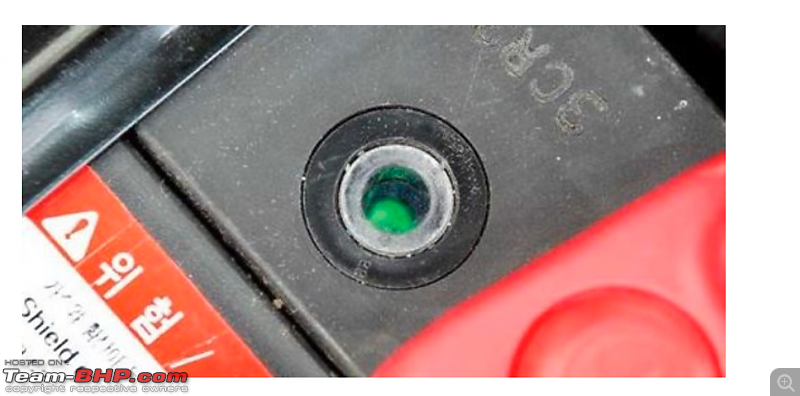 There are 4 main parts of a magic eye. Only the head and ball of the magic eye are visible to you. The colour you see in the magic eye’s indicator is actually a ball place inside the car battery. 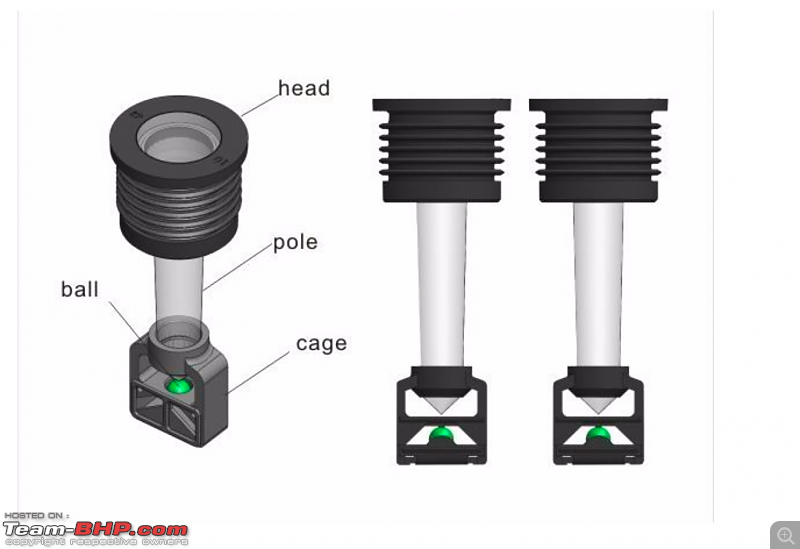 The coloured ball will float when its surrounded by the well-charged electrolyte in the car battery. On the other hand, the ball will sink when the electrolyte is under-charged. Another phase is when the electrolyte is at a low level where you will see a clear magic eye. 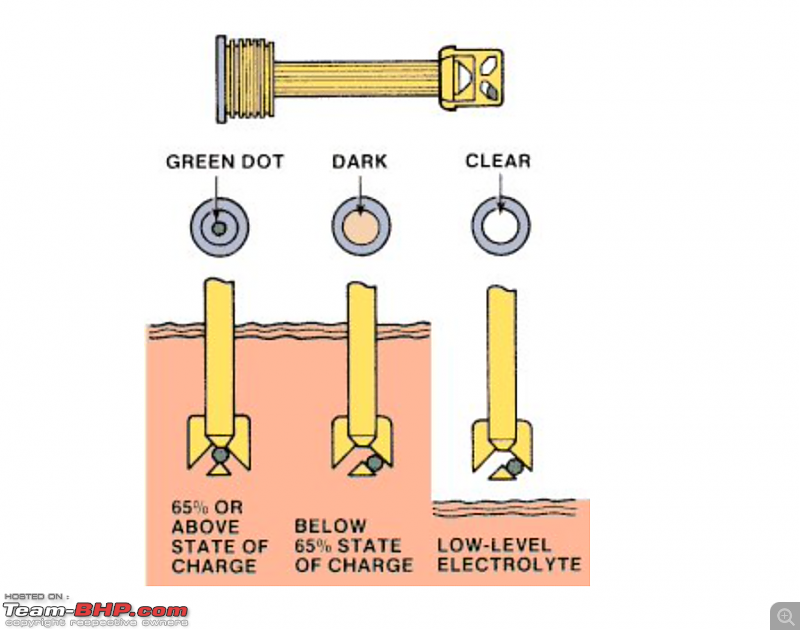 Jeroen | |
| |  (2)
Thanks (2)
Thanks
|
| The following 2 BHPians Thank Jeroen for this useful post: | PearlJam, Romins |
| | #10 |
| BHPian Join Date: Aug 2010 Location: Bangalore
Posts: 588
Thanked: 1,626 Times
| Re: DIY: Testing your car battery Our diesel generator battery has this magic indicator, with Red, clear and green options. But if it shows the condition of only one container as mentioned by others, then it seems not a correct indication. I would think that this type of indicator could be only for stable environments like in DG sets and may not be suitable for a very high vibration environment like cars. |
| |  (2)
Thanks (2)
Thanks
|
| The following 2 BHPians Thank fordday for this useful post: | Jeroen, Voodooblaster |
| | #11 | |
| Distinguished - BHPian  | Re: DIY: Testing your car battery Quote:
I haven't seen a battery in the West with these magic eyes for probably at least two decades. Jeroen | |
| |  ()
Thanks ()
Thanks
|
| |
| | #12 |
| BHPian Join Date: Jul 2019 Location: Gt.Bentley U.K.
Posts: 191
Thanked: 600 Times
| Re: DIY: Testing your car battery The "Magic Eye" was only ever a gimmick to promote sales of new batteries. I still see these in the garage in the UK, generally as auxiliary/leisure batteries on camper vans and motor homes. The auto sector have mostly dropped them. The leisure, camping and boating world still use them. They serve no real purpose and only measure the density "expressed" as "state of charge". People assume this indicates a healthy battery. It does not. Even a battery magic eye registering "all o.k." can still result in a battery too flat to start the engine. Their only possible saving grace is that they indicate when the level of electrolyte has fallen too low. But let's be honest !!! when did you last top up a car battery ? I have topped up 2 wheeler batteries, however those that need it are usually transparent and you can see the electrolyte level. The basic charging/regulating systems on most 2 wheelers also tend to charge the battery at higher than usual voltages in practice. That results in excess evaporation of the "water content" of the electrolyte. Most 2 wheeler batteries suffer more from the effects of vibration than low electrolyte levels anyway. Proper electronic diagnostic testing is the best way to determine battery health. |
| |  ()
Thanks ()
Thanks
|
| | #13 |
| Senior - BHPian Join Date: Sep 2012 Location: Pune
Posts: 1,194
Thanked: 4,711 Times
| Re: DIY: Testing your car battery Just the right thread at the right time! I recently moved to the U.K. and got a used 2017 Honda Jazz automatic. I did not check with the previous owner if it was a new battery, but it seemed like it was as the car cranked nicely every time (I cannot explain, you simply know what a good crank is when you turn the key  ) and the automatic-start-stop function worked without any warnings. ) and the automatic-start-stop function worked without any warnings. Back in India, I had an Ertiga with automatic start-stop function and it would stop working the moment the battery stopped holding charge even slightly as it got old and message would start flashing. Now after a 140 mile drive, for five days, the car was parked in freezing temperatures and just yesterday the car stopped responding to remote as if the electrical supply was cut off. The battery went completely flat for no reason. I am not sure if my kid left the interior light on when we got off (interestingly, the map lights lack automatic off feature when door is closed, which is common in Indian versions). Called up the AA and they jump started the car for me, then put some gadget on my car's battery which generated a QR code, the QR code in turn showed a result table on his mobile. It was a cool result set which showed lot of things, but particular interest were: 1. State of Charge: 0 as my battery was dead completely 2. State of Health: Could not determine as the battery was not charged sufficiently. We kept the car running for a few minutes, till the ammeter started showing higher current draw and plugged it in again. This time it showed some more values. 1. State of Charge: 40% 2. State of Health: Unable to determine <This was a bummer> 3. Time required to reach 80% of charging: 101 minutes, meaning I would have to drive the car at least 100 minutes to reach respectable charge status. 4. CCA and other stuff which essentially told the battery was able to 'hold' charge so it had not gone completely bad. Since the device could not show the state of health, the AA guy was not able to tell me if the battery is past its prime or it was just some light that drained the battery flat. We could only make some guesses. 1. The car, as per him, has electronics that determine if there is any constant current flowing when the car is off and it breaks off supply from battery completely if detected (say cabin lights on) in order to save battery. I am not so sure, need to read the user manual. My kid had fiddled with the lights again while car was dead. 2. The battery voltage was just 2.6xx volts initially, meaning it was completely dead, a low voltage of 8-10v should have made more sense, in India, they would have straight away asked me to change the battery. 3. It is an AGM battery, so as per him, if the battery is weak, it will simply drain down to lowest voltage in a couple of days, as bad AGM batteries don't hold charge. As for now, the car is in diagnostic mode, I am assured that if it does not drain in two days after a full charge, I can keep on using it for some more time. (It took some time for me to understand that in Scotland, people usually drive almost every day, so a weak battery is not that big an issue! ) All in all, I was quite happy with the device the AA guy had and the advice he gave. They kind of report the small thingy generated is all you need to see. I could not take photographs as it looked like some proprietary device with AA logo on it. I wish they had similar device at the authorised service centers back in India. Will save a lot of customer's time and money. Last edited by NiInJa : 4th January 2024 at 23:08. |
| |  (1)
Thanks (1)
Thanks
|
| The following BHPian Thanks NiInJa for this useful post: | Jeroen |
| | #14 |
| Distinguished - BHPian  Join Date: Aug 2009 Location: BLR/GAU
Posts: 935
Thanked: 9,651 Times
| Re: DIY: Testing your car battery Thank you Jeroen. Ending up buying yet another thing which I didn’t need but wanted anyways. I tested my Thar battery as it was as good as brand new and the results were pretty accurate. The SOH was at 100%, with SOC at 95% and voltage at 12.x. The battery is a 12V 70Ah Amaron with rated CCA of 560 (meter perceived it at 562). I bought it from amazon.in for around 2000₹ (Limited-time deal: STHIRA® Vehicle Battery Tester with LCD Display BM550 Car Battery Tester for 6V 12V 24V Vehicle Voltage Tester Internal Resistance Tester Digital Battery Analyzer for Car Motorcycles Lawn Mower https://amzn.eu/d/8uuOxtu) Attaching some images for reference: 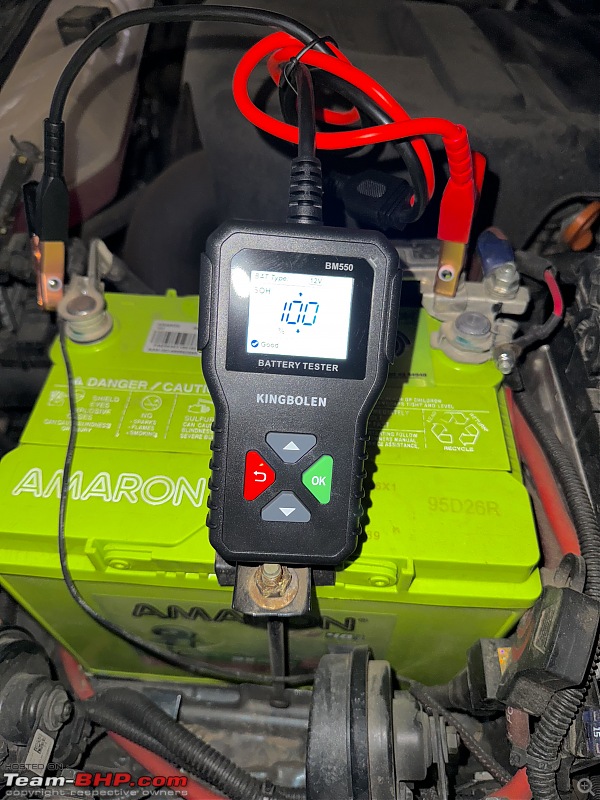 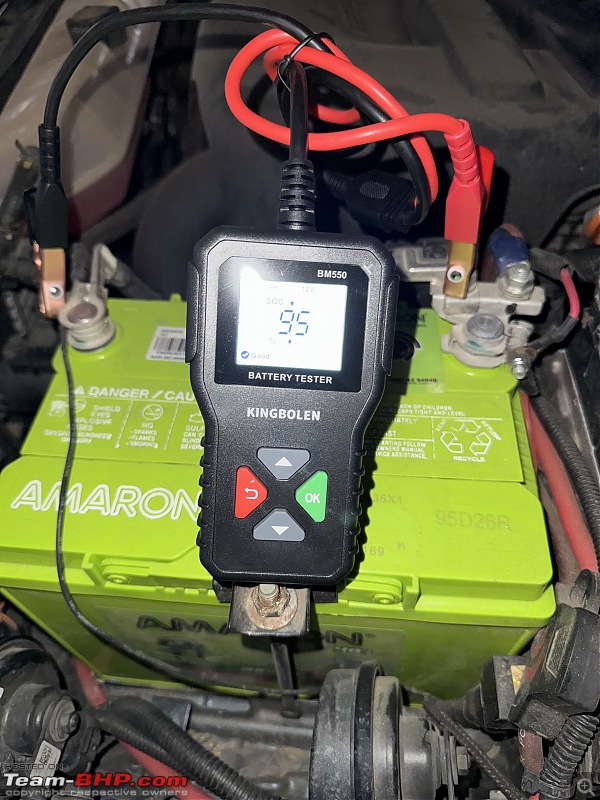 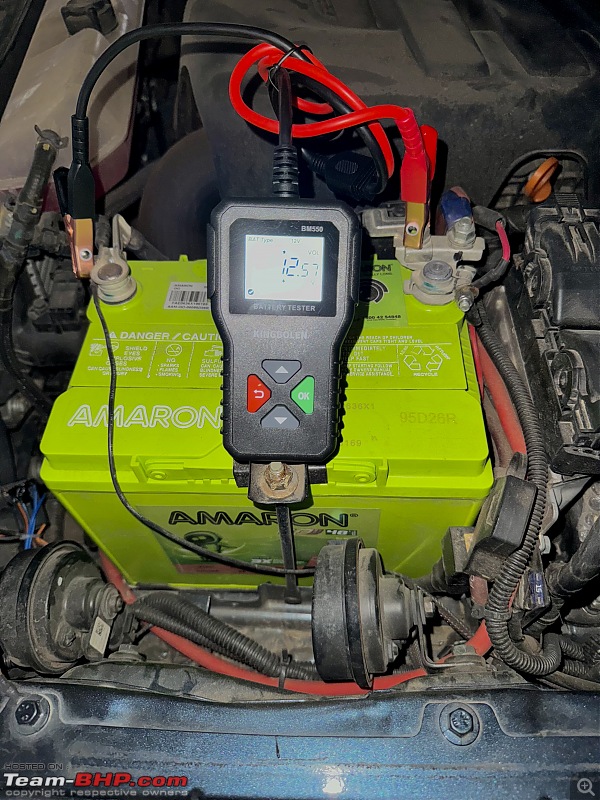 |
| |  (2)
Thanks (2)
Thanks
|
| The following 2 BHPians Thank robimahanta for this useful post: | Dr.AD, Jeroen |
| | #15 |
| Distinguished - BHPian  Join Date: Aug 2009 Location: BLR/GAU
Posts: 935
Thanked: 9,651 Times
| Re: DIY: Testing your car battery Checked the 3 series AGM Battery today. It is 3 years old and rated at 850CCA 92aH. Initially I had tested it via the jump start points in the engine bay and it gave some erroneous readings. Today I connected the tester directly to the battery in the boot and the readings seem to fine. CCA is 800 and SOH at 97% 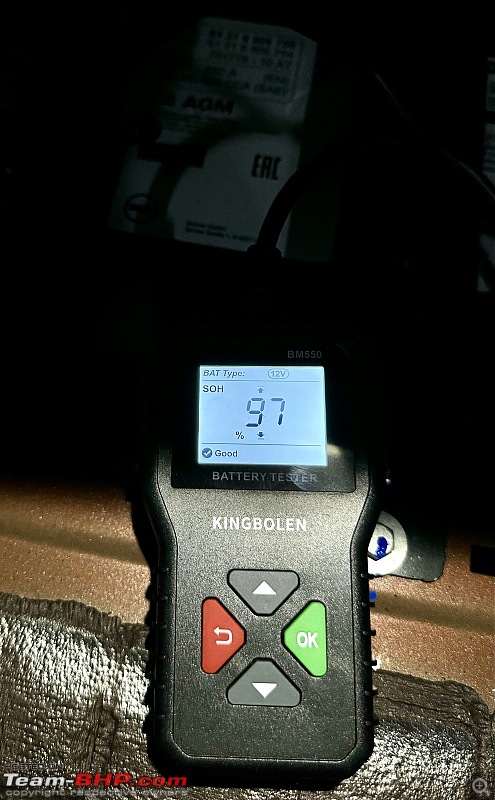 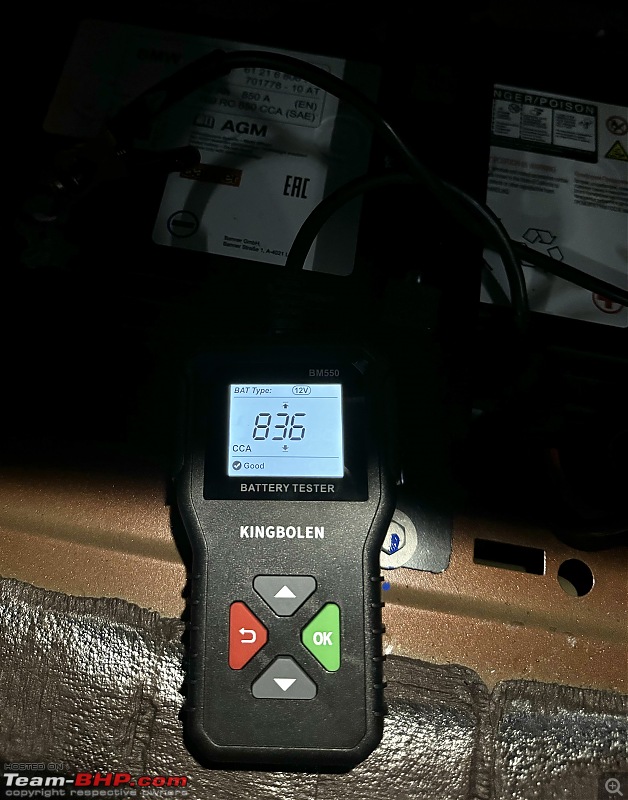 |
| |  (2)
Thanks (2)
Thanks
|
| The following 2 BHPians Thank robimahanta for this useful post: | Dr.AD, Jeroen |
 |


